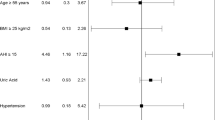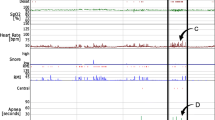Abstract
Purpose
This study aims to determine whether obstructive sleep apnea independently increases the risk of coronary events, including death from cardiovascular causes.
Methods
We conducted an observational cohort study among consecutive patients ≥50 years of age who were referred during 1997–2001 to the Yale Center for Sleep Medicine for suspected sleep-disordered breathing and were followed longitudinally for subsequent coronary events or cardiovascular death. Each study participant underwent an overnight polysomnography; obstructive sleep apnea was defined as an apnea–hypopnea index ≥5/h. The composite outcome during a mean duration of follow-up of 2.9 years was myocardial infarction, coronary artery revascularization procedures (angioplasty, stent placement, or coronary artery bypass graft surgery), or death from cardiovascular causes.
Results
Among 1,436 enrolled patients, 1,024 (71%) had an apnea–hypopnea index ≥5/h. In an unadjusted analysis, obstructive sleep apnea was associated with an increased risk of coronary events or cardiovascular death (hazard ration (HR) 2.57, 95% confidence interval (CI) 1.39–4.72, P = 0.003). After adjustment for traditional cardiovascular risk factors (including body mass index and hypertension), obstructive sleep apnea retained a statistically significant association with this composite outcome (HR 2.06, 95% CI 1.10–3.86, P = 0.024).
Conclusion
Obstructive sleep apnea increases the risk of coronary events or death from cardiovascular causes.

Similar content being viewed by others
References
Rosamond W, Flegal K, Friday G et al (2007) Heart and stroke statistics—2007 update. Circulation 115:e69–e171
Young T, Palta M, Dempsey J, Skatrud J, Weber S, Badr S (1993) The occurrence of sleep-disordered breathing among middle-aged adults. N Engl J Med 328:1230–1235
Mooe T, Rabben T, Wiklund U, Franklin KA, Eriksson P (1996) Sleep-disordered breathing in women: occurrence and association with coronary artery disease. Am J Med 101(3):251–256
Marin JM, Carrizo SJ, Vicente E, Agusti AG (2005) Long-term cardiovascular outcomes in men with obstructive sleep apnoea–hypopnoea with or without treatment with continuous positive airway pressure: an observational study. Lancet 365(9464):1046–1053
Peker Y, Carlson J, Hedner J (2006) Increased incidence of coronary artery disease in sleep apnoea: a long-term follow-up. Eur Respir J 28(3):596–602
Johns MW (1991) A new method for measuring daytime sleepiness: the Epworth sleepiness scale. Sleep 14:540–545
Yaggi H, Concato J, Kernan W, Lichtman J, Brass L, Mohsenin V (2005) Obstructive sleep apnea as a risk factor for stroke and death. New Engl J Med 353:2034–2041
American Academy of Sleep Medicine Task Force (1999) Sleep-related breathing disorders in adults: recommendations for syndrome definition and measurement techniques in clinical research. The report of an American Academy of Sleep Medicine Task Force. Sleep 22(5):667–689
Meoli AL, Casey KR, Clark RW et al (2001) Hypopnea in sleep-disordered breathing in adults. Sleep 24(4):469–470
Joint European Society of Cardiology/American College of Cardiology Committee for the Redefinition of Myocardial Infarction (2002) Myocardial infarction redefined—a consensus document of the Joint European society of cardiology/American College of Cardiology Committee for the Redefinition of Myocardial Infarction. Eur Heart J 21:1502–1513
Hill ME, Rosenwaike I (2001) The social security administration’s death master file: the completeness of death reporting at older ages. Soc Secur Bull 64(1):45–51
ancestry.com (1999) Social Security Death Index. http://www.ancestry.com/search/rectype/vital/ssdi/main.htm]. Accessed 15 February 2009
Young T, Finn L, Peppard PE et al (2008) Sleep disordered breathing and mortality: eighteen-year follow-up of the Wisconsin sleep cohort. Sleep 31(8):1071–1078
Schoenfeld DA (1983) Sample-size formula for the proportional-hazards regression model. Biometrics 39(2):499–503
Davignon J, Ganz P (2004) Role of endothelial dysfunction in atherosclerosis. Circulation 109(23 Suppl 1):III27–III32
Lorenzi-Filho G, Drager LF (2007) Obstructive sleep apnea and atherosclerosis: a new paradigm. Am J Respir Crit Care Med 175(12):1219–1221
Savransky V, Nanayakkara A, Li J et al (2007) Chronic intermittent hypoxia induces atherosclerosis. Am J Respir Crit Care Med 175(12):1290–1297
Ip MS, Lam B, Ng MM, Lam WK, Tsang KW, Lam KS (2002) Obstructive sleep apnea is independently associated with insulin resistance. Am J Respir Crit Care Med 165(5):670–676
Punjabi N, Sorkin J, Katzel L, Goldberg A, Schwartz A, Smith P (2002) Sleep-disordered breathing and insulin resistance in middle-aged and overweight men. Am J Respir Crit Care Med 165:677–682
Drager LF, Bortolotto LA, Figueiredo AC, Krieger EM, Lorenzi GF (2007) Effects of continuous positive airway pressure on early signs of atherosclerosis in obstructive sleep apnea. Am J Respir Crit Care Med 176(7):706–712
Peppard P, Young T, Palta M, Skatrud JB (2000) Prospective study of the association between sleep-disordered breathing and hypertension. NEJM 342(19):1378–1384
Sources of support
National Research Service Award Institutional Research Training Grant from the National Institutes of Health (T32 HL00778-12), Yale Center for Sleep Medicine, Career Development Award from the Veterans Affairs Health Services Research and Development Service
Author information
Authors and Affiliations
Corresponding author
Additional information
Dr. Henry Klar Yaggi and Dr. Neomi A. Shah contributed equally to this study and manuscript.
Rights and permissions
About this article
Cite this article
Shah, N.A., Yaggi, H.K., Concato, J. et al. Obstructive sleep apnea as a risk factor for coronary events or cardiovascular death. Sleep Breath 14, 131–136 (2010). https://doi.org/10.1007/s11325-009-0298-7
Received:
Accepted:
Published:
Issue Date:
DOI: https://doi.org/10.1007/s11325-009-0298-7




